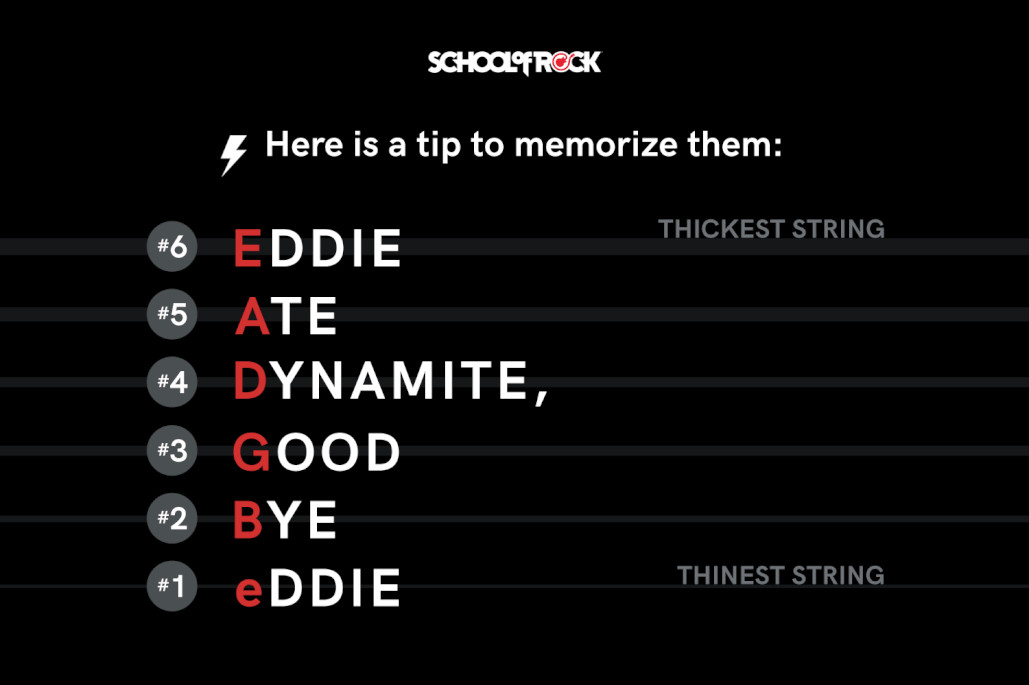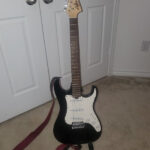Learning to tune your electric guitar is a fundamental skill for any beginner. An out-of-tune guitar simply won’t produce the sounds you expect, no matter how well you play. This guide will walk you through identifying Electric Guitar String Notes, tuning your guitar effectively (with and without a tuner), and maintaining your tuning for longer periods. Regular, in-tune practice is not only more enjoyable but also crucial for developing your ear and technique.
The Basics of Electric Guitar Tuning
Electric guitar tuning is achieved by adjusting the tuning pegs located on the guitar’s headstock. These pegs control the tension of the strings. Turning a peg clockwise increases string tension, raising the pitch, while turning it counter-clockwise loosens the string, lowering the pitch. Understanding this basic mechanism is the first step to mastering tuning.
How Often Should You Tune Your Electric Guitar?
Ideally, you should tune your electric guitar every time you pick it up to play. Electric guitars are susceptible to going out of tune due to various factors, including temperature changes, humidity, and even just the act of playing itself, especially vigorous playing with string bending or extended practice sessions. It’s wise to periodically check your electric guitar tuning throughout your practice. If chords start to sound dissonant, even when you’re confident in your finger placement, it’s a clear sign that your guitar needs retuning.
[instruction]
Insert image here
The first image from the original article is:
{width=1280 height=720}
Alt text should be descriptive and SEO-friendly.
Thinking process for ALT text:
- Original alt/title: “Play![Play Button]…” – Not helpful for SEO or accessibility.
- Image URL: youtube.com/vi/9v5ZfswENug – Suggests a video related to tuning.
- Article context: Tuning a guitar.
- Surrounding text: How often to tune.
- New alt text idea: “Guitar tuning demonstration video on YouTube showing the importance of regular tuning for electric guitars.” – Keywords: guitar tuning, electric guitars, YouTube video, demonstration, regular tuning, importance.
- Refined alt text for conciseness and SEO: “Electric guitar tuning demonstration video highlighting the importance of keeping your instrument in tune.”
[/instruction]

Methods for Tuning Your Electric Guitar
Modern technology has made tuning incredibly accessible and straightforward. Electronic tuners are now commonplace, offering quick and accurate tuning. Alternatively, you can tune by ear using a reference note, a traditional method that develops your aural skills.
Tuning with Electronic Tuners: Chromatic and Clip-On
Electronic tuners, particularly clip-on chromatic tuners, have transformed the tuning process for guitarists. Unlike older plug-in models, clip-on tuners attach directly to your guitar’s headstock and detect string vibrations. These tuners are incredibly user-friendly, indicating whether a string is flat (too low), sharp (too high), or perfectly in tune. They are suitable for both acoustic and electric guitars. Affordable, precise, and convenient, clip-on tuners are highly recommended for beginners and experienced players alike. Many modern electric guitar amplifiers also include built-in tuners for added convenience.
Tuning Your Electric Guitar Without a Tuner
Knowing how to tune your electric guitar without an electronic tuner is a valuable skill. Situations may arise where you don’t have a tuner readily available, such as when traveling or in impromptu jam sessions.
Fortunately, smartphone apps offer a readily accessible tuning solution. Numerous tuner apps are available, many of which are free. These apps utilize your device’s microphone to detect the pitch of your guitar strings and provide visual feedback as you adjust your tuning. As you manipulate the tuning pegs, the app’s display will indicate when the string reaches the correct pitch.
Another method for tuning without a tuner involves using a reference pitch from a known in-tune source, such as a piano or another guitar.
This method requires a more developed ear as you must tune one string to the reference pitch by ear. This involves playing the reference note, playing the corresponding note on your electric guitar, and carefully comparing the two pitches. Adjust your guitar string’s tuning until it matches the reference pitch. Once you have one string correctly tuned, you can tune the remaining electric guitar string notes relative to that initial string. This is done by fretting a note on a lower string and tuning the next higher open string to match that fretted note.
Identifying Electric Guitar String Names and Notes: EADGBE
Standard tuning for a 6-string electric guitar utilizes the following string notes, from thickest (lowest pitch) to thinnest (highest pitch): E, A, D, G, B, e.
[instruction]
Insert image here
Second image from original article:
{width=1029 height=685}
Original alt text: “To tune a guitar without a tuner, first identify the guitar notes.”
Need to improve alt text for SEO and better description.
Thinking process for ALT text:
- Original alt text is okay but can be more descriptive and keyword focused.
- Image content: Shows guitar headstock with string names and notes EADGBE.
- Article context: Identifying string notes.
- Surrounding text: String names EADGBE and mnemonics.
- New alt text idea: “Diagram showing the standard electric guitar string notes E A D G B E from thickest to thinnest string for tuning reference.” – Keywords: electric guitar string notes, EADGBE, tuning reference, diagram, string names.
- Refined alt text for conciseness and SEO: “Diagram illustrating the standard EADGBE electric guitar string notes for tuning.”
[/instruction]

To aid in memorizing these electric guitar string names, several mnemonics are commonly used. Popular examples include “Eddie Ate Dynamite, Good Bye Eddie” and “Eat A Dead Goose Before Eating.” The thinnest string is designated as the 1st string (high E), while the thickest is the 6th string (low E).
[instruction]
Insert image here
Third image from original article:
{width=1029 height=685}
Original alt text: “Here is a tip to memorize the guitar string names: Eddie Ate Dynamite, Good Bye Eddie.”
Again, improve alt text for SEO and description.
Thinking process for ALT text:
- Original alt text is okay but can be improved.
- Image content: Text “Eddie Ate Dynamite, Good Bye Eddie” to memorize string names.
- Article context: Mnemonics for string names.
- Surrounding text: Explains mnemonics.
- New alt text idea: “Mnemonic phrase ‘Eddie Ate Dynamite, Good Bye Eddie’ to help beginners memorize electric guitar string names E A D G B E.” – Keywords: mnemonic phrase, electric guitar string names, EADGBE, memorize, beginners.
- Refined alt text for conciseness and SEO: “Mnemonic ‘Eddie Ate Dynamite Good Bye Eddie’ for memorizing electric guitar string notes.”
[/instruction]

Beyond standard tuning, exploring alternate guitar tunings can open up new sonic possibilities and are worth investigating as you progress as a guitarist.
Step-by-Step Tuning of Each Electric Guitar String Note
Let’s break down the process of tuning each electric guitar string note individually using the method of relative tuning (tuning one string to another).
Tuning Your Low E String (6th String)
If you have a reference pitch (from a piano, tuning fork, or another instrument), begin by tuning your low E string (the thickest string) to that reference. If no reference pitch is available, you can use the 7th fret of the A string (5th string) as an E note to tune your low E string to.
Detailed Steps for Tuning the 6th String (Low E)
- Play a reference E note: If available, play an E note from a reference source. If not, fret the A string at the 7th fret and play that note.
- Play the open 6th string: Pluck the open low E string on your electric guitar.
- Compare pitches: Listen carefully to the reference E note and the open 6th string.
- Adjust tuning peg: If the 6th string’s pitch is lower than the reference (flat), tighten the tuning peg. If it’s higher (sharp), loosen the tuning peg.
- Repeat and refine: Continue playing both notes and making adjustments until the pitch of your open 6th string precisely matches the reference E note.
Tuning Your A String (5th String)
Once the low E string is in tune, you can tune the A string. Fret the low E string at the 5th fret. This fretted note is an A. Tune your open A string (5th string) to match the pitch of this fretted note.
Detailed Steps for Tuning the 5th String (A)
- Fret the 5th fret of the 6th string: Press down the 6th string at the 5th fret and play the note. This is your reference A note.
- Play the open 5th string: Pluck the open A string on your electric guitar.
- Compare pitches: Listen to the fretted note on the 6th string and the open 5th string.
- Adjust tuning peg: Adjust the tuning peg for the A string until its pitch matches the reference A note from the 6th string.
- Refine: Repeat until both notes are in perfect unison.
Tuning Your D String (4th String)
To tune the D string, fret the A string (5th string) at the 5th fret. This produces a D note. Tune your open D string (4th string) to this reference.
Detailed Steps for Tuning the 4th String (D)
- Fret the 5th fret of the 5th string: Fret the 5th string at the 5th fret and play the note – your reference D note.
- Play the open 4th string: Pluck the open D string of your electric guitar.
- Compare pitches: Compare the pitches of the fretted note and the open D string.
- Adjust tuning peg: Tune the D string using its tuning peg until it matches the reference D.
- Perfect the tuning: Fine-tune until both pitches are identical.
Tuning Your G String (3rd String)
Tune the G string by fretting the D string (4th string) at the 5th fret. This fretted note is a G. Tune your open G string (3rd string) to match it.
Detailed Steps for Tuning the 3rd String (G)
- Fret the 5th fret of the 4th string: Fret the 4th string at the 5th fret to create a reference G note.
- Play the open 3rd string: Play the open G string on your electric guitar.
- Compare pitches: Listen closely to the fretted G and the open G string.
- Adjust tuning peg: Adjust the G string’s tuning peg until it matches the reference G.
- Ensure accurate tuning: Refine until the pitches are the same.
Tuning Your B String (2nd String)
The B string tuning is slightly different. Fret the G string (3rd string) at the 4th fret (not the 5th). This fretted note is a B. Tune your open B string (2nd string) to match this pitch.
Detailed Steps for Tuning the 2nd String (B)
- Fret the 4th fret of the 3rd string: Fret the 3rd string at the 4th fret to get a reference B note.
- Play the open 2nd string: Play the open B string of your electric guitar.
- Compare pitches: Compare the fretted B and the open B string.
- Adjust tuning peg: Tune the B string using its tuning peg until it matches the reference B.
- Fine-tune: Ensure both pitches are exactly the same.
Tuning Your High E String (1st String)
Finally, to tune the high E string, fret the B string (2nd string) at the 5th fret. This is an E note. Tune your open high E string (1st string) to match.
Detailed Steps for Tuning the 1st String (High E)
- Fret the 5th fret of the 2nd string: Fret the 2nd string at the 5th fret to produce a reference high E note.
- Play the open 1st string: Play the open high E string on your electric guitar.
- Compare pitches: Compare the fretted high E and the open high E string.
- Adjust tuning peg: Adjust the high E string’s tuning peg until it matches the reference E.
- Verify tuning: Double-check to ensure perfect unison.
Once you’ve become comfortable with tuning each electric guitar string note, you’ll be ready to explore more advanced techniques like reading guitar tabs and learning your favorite songs!
[instruction]
Insert image here
Fourth image from original article:
{width=1029 height=770}
This is an advertisement image, alt text should be different and not promotional, but descriptive of image content.
Thinking process for ALT text:
- Original image is promotional for summer camps.
- Article context: Tuning, learning guitar. Image is placed after tuning instructions and before “keeping in tune” section.
- Image content: Shows kids playing guitars in a band setting.
- New alt text idea (initially promotional): “School of Rock summer camps offer guitar lessons and band experience for young musicians.” – Too promotional.
- New alt text idea (descriptive and relevant): “Young students learning electric guitar in a band setting, highlighting the fun and collaborative aspect of music education.” – Keywords: students, electric guitar, band setting, music education, collaborative learning.
- Refined alt text for conciseness and relevance: “Students playing electric guitars in a band setting, emphasizing collaborative music learning.”
[/instruction]

Guitar Summer Camps
Summer camps, like those offered at School of Rock, provide an immersive environment to learn not only how to tune an electric guitar but also how to play your favorite songs in a band context. These camps offer workshops covering songwriting, stage presence (building stage presence), and more, catering to all skill levels.
View Summer Camps
Maintaining Your Electric Guitar Tuning
Once you’ve tuned your electric guitar, there are several preventative measures you can take to help it stay in tune for longer periods.
- Regular String Changes: Strings lose their elasticity and intonation over time. When your electric guitar strings begin to sound dull or frequently go out of tune, it’s time to replace them. Fresh strings hold their tuning much better.
- String Stretching Technique: When installing new strings, remember to stretch them properly. Gently pull on the strings or play vigorously after stringing to accelerate the stretching process. Be cautious not to pull too forcefully, which could cause breakage.
- Proper Guitar Care and Storage: Protect your electric guitar from drastic changes in temperature and humidity. Extreme fluctuations can cause the wood to expand or contract, affecting tuning stability. After playing, wipe down the strings with a clean, soft cloth and store your guitar in its case or gig bag when not in use. This protects it from environmental changes and physical bumps.
By utilizing electronic tuners or mastering tuning by ear, and by implementing these maintenance tips, you’ll ensure your electric guitar remains in tune, making your practice sessions more productive and enjoyable.
Considering a new electric guitar? Explore our Guitar Buying Guide

